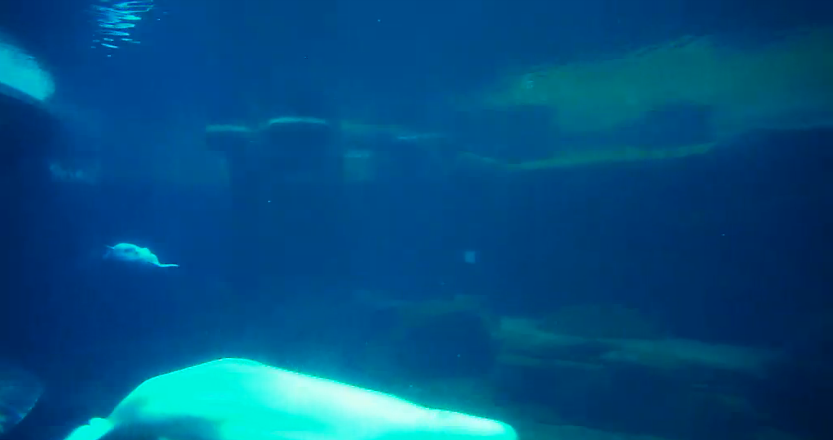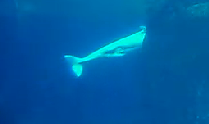Concerning Belugas: Meet Captain Nemo and Wake
CARPE DIEM
8:27 PM
Beluga Webcam, courtesy of Vancouver Aquarium
Disclaimer: Any images, unless otherwise specified, are screenshots that I've taken from the above linked webcam.
The webcam that I am currently spending hours ogling over is provided by Vancouver Aquarium: specifically, the Beluga Whale cam. Belugas are an animal that I know little about, and indeed have spent little time thinking about them. At least partially, this is due to lack of coverage: I don't think I've ever come across an article about a Beluga. Only as of about 1 minute ago do I know that Belugas are classified as "near threatened" according to the IUCN Red List: this is largely due to the minor, but continued practice of Beluga Whale consumption.
I think my complete ignorance on this species is one of the reasons why I decided to observe these animals. Having a great love for the oceans and it inhabitants I make it my mission to know as much as I can about them, and when I saw a link to a Beluga webcam I couldn't resist. And so here we are.
My previous (and first) post, recording, what is probably just incoherent ramblings of a mesmerised, wannabe scientist is just that: a bullet point list of random observations. Later on I will see what I can do to analyse some of those behaviours, however, for today I wanted to introduce myself to the aquariums inhabitants.
The whales seem to be taking turns appearing in the scope of the camera, however, a few times (as pictures here) they can be seen together. Belugas are incredibly social animals, travelling in small pods, as many whales practice; they are known as being incredibly vocal, although unfortunately their is no audio feature in this footage.
Very early on I was exposed to what I've learned is a typical behaviour: swimming upside down. Although, I haven't researched this behaviour as of yet, I will be sure to do so. What I've noticed is that when swimming as pictured to the right the whales neglect using their head. When they are swimming the 'correct' way they move their heads up and down- suggesting that this helps to propel them forward. I think my assumption is furthered by the fact that the whales appear to move much quicker when upright. So with my very limited knowledge about this animal I believe that while swimming 'normally' allows them to move at greater speeds, swimming 'abnormally' allows them to save energy. However, the thing I wanted to discuss was what I noticed on one of the whales, that has developed into its distinguishing factor. When swimming upside down I noticed an odd indentation near the base of one of the whale's tails. I waited (for quite a long period of time) until I saw both of the whales at once, so that I could confirm that this indentation wasn't a normal characteristic for belugas. When seen from a side angle the formation looks something like the number eight.
Although on closer inspection it looks more like a circular indentation with two linear indents leading off of it. Anyway, I'm not entirely certain what this formation is, whether it's natural, or obtained sometime during this animal's life, nonetheless, it helps me to distinguish this animal from the other. I've taken to calling this Beluga, Captain Nemo, after the character in 20,000 Leagues Under the Sea (one of my favourites).
I was quite pleased with myself for having found a way to distinguish the two animals until I realised that it was useless unless Captain Nemo happened to rotate his body. So it was back to the drawing board for me. Until I observed another oddly shaped formation on one of the whales' bodies: on either side of it ridge like structures could be seen jutting out of the main tail. It was only until I was able to see these structures on the whale then witness it turning that I could confirm that those ridges made up the figure eight I'd spotted earlier.
Unfortunately, I've been unable to find a distinguishing feature on the remaining Beluga, although I'm still hopeful to spot something. I've taken to calling this elusive Beluga, Wake.
That's it for today!
Disclaimer: Any images, unless otherwise specified, are screenshots that I've taken from the above linked webcam.
The webcam that I am currently spending hours ogling over is provided by Vancouver Aquarium: specifically, the Beluga Whale cam. Belugas are an animal that I know little about, and indeed have spent little time thinking about them. At least partially, this is due to lack of coverage: I don't think I've ever come across an article about a Beluga. Only as of about 1 minute ago do I know that Belugas are classified as "near threatened" according to the IUCN Red List: this is largely due to the minor, but continued practice of Beluga Whale consumption.
I think my complete ignorance on this species is one of the reasons why I decided to observe these animals. Having a great love for the oceans and it inhabitants I make it my mission to know as much as I can about them, and when I saw a link to a Beluga webcam I couldn't resist. And so here we are.
My previous (and first) post, recording, what is probably just incoherent ramblings of a mesmerised, wannabe scientist is just that: a bullet point list of random observations. Later on I will see what I can do to analyse some of those behaviours, however, for today I wanted to introduce myself to the aquariums inhabitants.
The whales seem to be taking turns appearing in the scope of the camera, however, a few times (as pictures here) they can be seen together. Belugas are incredibly social animals, travelling in small pods, as many whales practice; they are known as being incredibly vocal, although unfortunately their is no audio feature in this footage.
Very early on I was exposed to what I've learned is a typical behaviour: swimming upside down. Although, I haven't researched this behaviour as of yet, I will be sure to do so. What I've noticed is that when swimming as pictured to the right the whales neglect using their head. When they are swimming the 'correct' way they move their heads up and down- suggesting that this helps to propel them forward. I think my assumption is furthered by the fact that the whales appear to move much quicker when upright. So with my very limited knowledge about this animal I believe that while swimming 'normally' allows them to move at greater speeds, swimming 'abnormally' allows them to save energy. However, the thing I wanted to discuss was what I noticed on one of the whales, that has developed into its distinguishing factor. When swimming upside down I noticed an odd indentation near the base of one of the whale's tails. I waited (for quite a long period of time) until I saw both of the whales at once, so that I could confirm that this indentation wasn't a normal characteristic for belugas. When seen from a side angle the formation looks something like the number eight.
Although on closer inspection it looks more like a circular indentation with two linear indents leading off of it. Anyway, I'm not entirely certain what this formation is, whether it's natural, or obtained sometime during this animal's life, nonetheless, it helps me to distinguish this animal from the other. I've taken to calling this Beluga, Captain Nemo, after the character in 20,000 Leagues Under the Sea (one of my favourites).
I was quite pleased with myself for having found a way to distinguish the two animals until I realised that it was useless unless Captain Nemo happened to rotate his body. So it was back to the drawing board for me. Until I observed another oddly shaped formation on one of the whales' bodies: on either side of it ridge like structures could be seen jutting out of the main tail. It was only until I was able to see these structures on the whale then witness it turning that I could confirm that those ridges made up the figure eight I'd spotted earlier.
Unfortunately, I've been unable to find a distinguishing feature on the remaining Beluga, although I'm still hopeful to spot something. I've taken to calling this elusive Beluga, Wake.
That's it for today!















